The cold season of winter presents a distinctive challenge for those who love their bonsai trees, as the harsh weather can be tough on these miniature marvels. However, knowing how to prepare bonsai for winter can make all the difference. With the correct preparation and attention, your bonsai trees can not only withstand the winter but flourish and come alive with vigor when spring shows up. This guide will provide you with the necessary knowledge on how to ready your bonsai for the frosty months ahead.
Here’s a quick look at what this blog post will talk about:
- Understanding the concept of bonsai dormancy
- The necessity of root protection for bonsai
- Crucial timing and preparatory steps for overwintering bonsai
- Various winter storage options
- Indoor and outdoor bonsai care during freezing weather
Understanding Bonsai Dormancy

Before we embark on the journey of winter-proofing your bonsai, it is essential to grasp a fundamental aspect of their life cycle, the dormancy phase. Bonsai trees, like their full-sized counterparts, have an annual rhythm—active growth in spring and summer, slow down in fall, and rest in winter.
Temperate Trees and Exposure to Cold Weather
For many temperate trees, dormancy is a natural process that occurs in response to colder weather.
As temperatures drop, the tree’s metabolic processes slow down, allowing them to conserve energy until the weather warms up again.
However, it’s important to note that not all trees go dormant in the same way. Some species, such as oak trees, may keep their leaves throughout winter, while others lose their leaves during this time.
Understanding the individual traits of your tree species is crucial when learning how to prepare your bonsai for winter.
Winter Hardiness of Temperate Species
The cold hardiness of a species determines how low temperatures can drop before it becomes damaged, so it’s important to research the plant before purchasing it for your collection.
This information can be found on the nursery labels or online and is usually given in terms of a minimum hardiness zone.
For example, a plant rated at zone 5b can typically withstand freezing temperatures as low as -15°F. Keep this information in mind when placing your trees during winter, as proper placement can help ensure their survival.
Elevation, Precipitation, and Season Length Factors
Elevation, precipitation, and season length can have a significant impact on your trees’ dormancy period.
Trees at higher elevations often have a shorter growing season and, therefore, may need a longer dormancy period to prepare bonsai for winter.
Additionally, adequate moisture is necessary for a successful dormancy process, as water stress can disrupt the process and lead to damage. By providing adequate water and understanding the unique factors of your tree’s environment, you can ensure its survival through the winter.
Root Protection for Bonsai
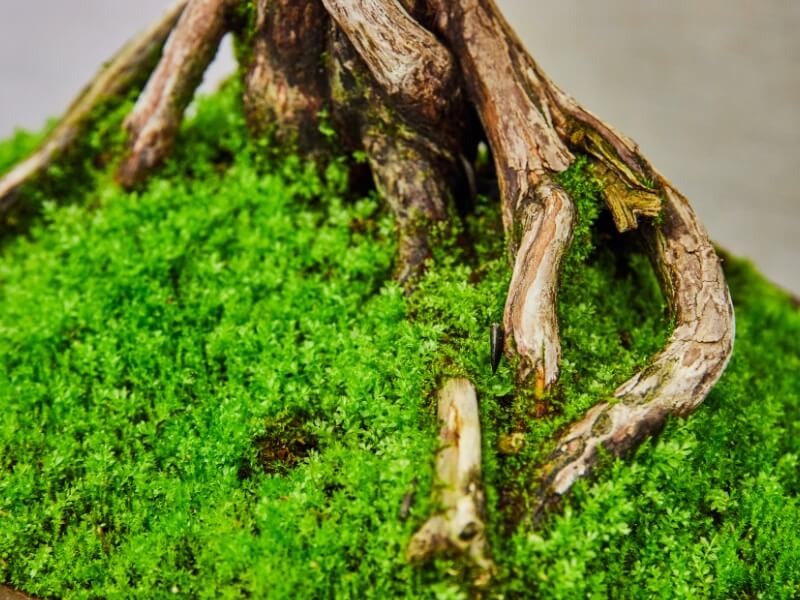
Protecting the roots of your bonsai during winter is vitally important. This is especially true due to the shallow pot in which it resides, making it more susceptible to freezing conditions.
Risks of a Shallow Bonsai Pot during Winter
Shallow containers are a popular choice for bonsai enthusiasts because they create the illusion of a larger tree and draw attention to the trunk.
However, they can be dangerous for the roots during the winter season. Shallow containers have less soil, less insulating material, and less space for the roots to grow. This means that they are more susceptible to freezing and damage from cold temperatures.
During the winter, the roots could freeze entirely, damaging or even killing the tree.
Cold Frames and Greenhouses for Cold Area Residents
One way to protect your bonsai roots during the winter season is to use a cold frame or a greenhouse. These structures provide insulation and shelter from the cold winds, keeping the bonsai roots at a stable temperature.
Additionally, they allow you to continue to care for the bonsai tree even during the winter season and provide enough sunlight and warmth for the tree to grow.
Alternative Protection Methods: Styrofoam Covers, Planting in the Garden
Another alternative that bonsai owners can use to protect their trees is by using Styrofoam covers.
These covers are readily available in nurseries, and they provide insulation to the tree’s roots.
Styrofoam promotes water retention, keeping the soil moist in winter, which is critical for the health of the bonsai. Styrofoam covers are easy to install and can be removed during the day to allow sunlight through to the tree.
If you live in an area with consistently mild winters, planting your bonsai in the garden could be a suitable protection method.
Planting allows the bonsai to draw moisture from the ground and get all the nutrients it needs. This is the most natural way of protecting the bonsai tree, and it also grants the tree more stylistic freedom and natural growth.
Timing and Preparatory Steps for Overwintering Bonsai

Timing for overwintering bonsai trees begins in the fall, requiring steps like leaf removal, insect and fungus treatment, and fertilizer buildup clearance. Post-preparation, it’s essential to monitor the trees until dormancy, maintaining temperature and humidity levels and sustaining water schedules while also protecting them from extreme weather.
Winter Storage Options for Your Bonsai
Finding the right winter storage for your bonsai is a key step as you prepare bonsai for winter, ensuring its survival during the cold months. The choice between indoor and outdoor storage depends on your local climate, the bonsai species, and the space available.
Indoor Storage Solutions
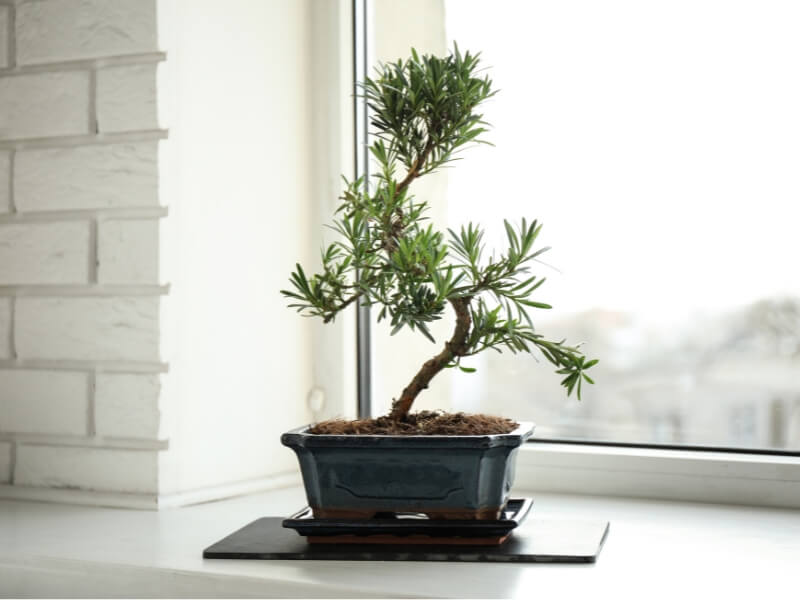
1. Heated Patios
Heated patios serve as an excellent winter refuge for your bonsai trees. Maintaining a steady temperature of around 40-50°F will ensure your trees neither freeze nor overheat.
2. Sunrooms
Sun-drenched rooms, particularly sunrooms, are especially beneficial for tropical trees. The copious amounts of natural sunlight they receive make them a prime storage location.
3. Greenhouses
For those lucky enough to own a greenhouse, it’s the ideal environment for wintering bonsai trees. The ample sunlight and controlled environment protect not only from the cold but also pests and other environmental threats.
4. Climate-controlled Basements
Climate-controlled basements provide a stable, protected environment against temperature fluctuations. This steady environment makes them a viable storage alternative for the colder months.
Outdoor Storage Options
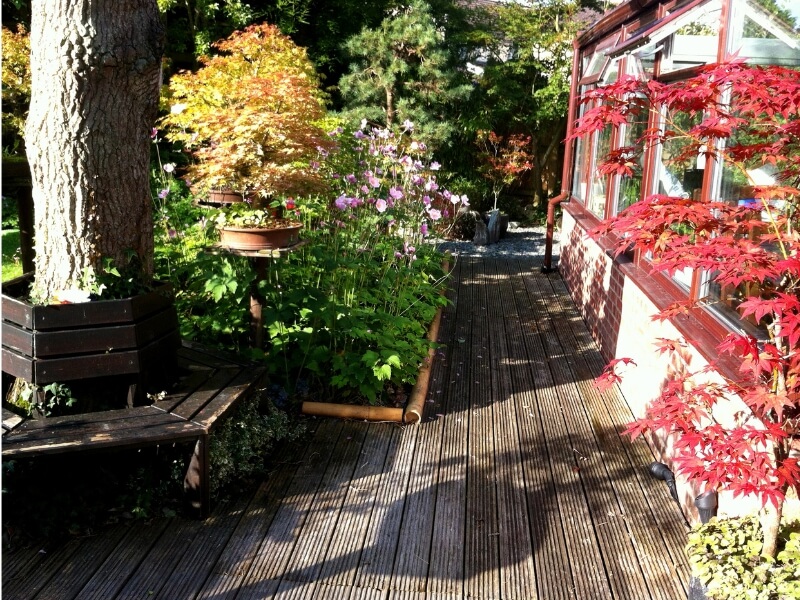
1. Under Benches
One of the easiest and most popular outdoor storage options is to keep your bonsai trees under benches. This provides shade and protection against direct sunlight.
2. Burying in the Garden
This is an alternative option for trees that can survive the cold winter. You could plant your bonsai trees in the garden in bonsai pots and bury them underground. This provides insulation and keeps your trees somewhat protected against the cold.
3. Mulch beds
Mulch beds provide insulation and help regulate moisture levels in the soil. You could create a protective barrier around your trees using mulch.
4. Unheated Garages or Sheds
If you have an unheated garage or shed, it can be an excellent option for storing trees. You want to be sure that the trees in an unheated place are protected against direct sunlight and frost.
5. Cold Frames
Cold frames are like mini-greenhouses that provide protection for your trees. You could build one yourself using transparent plastic, PVC pipes, or old windows.
Indoor Bonsai Care during Winter
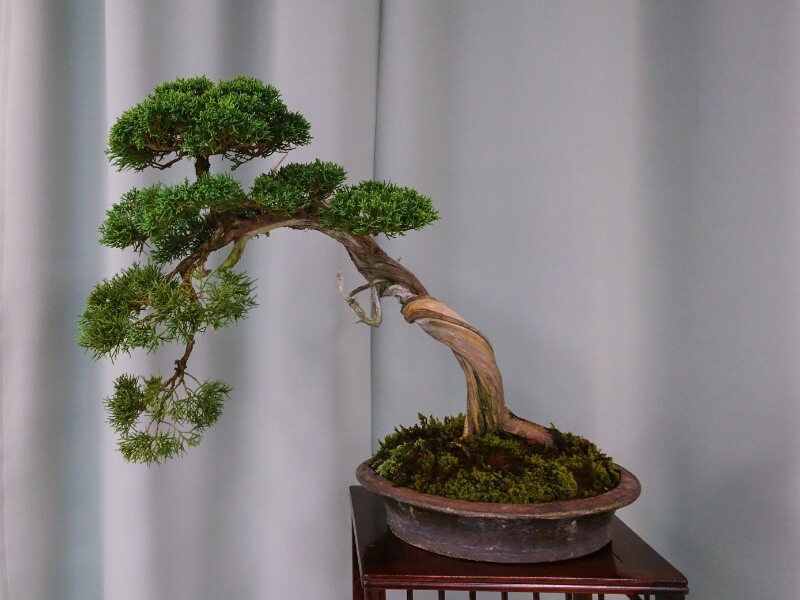
Ensuring Dormancy for Temperate Trees
As discussed above, temperate bonsai trees need to enter dormancy during winter to survive the colder weather.
To induce dormancy, you should gradually reduce watering and fertilization as temperatures begin to drop. As the tree’s leaves begin to yellow and fall off, move it to a cooler location for about 4-6 weeks.
During this time, monitor the soil’s moisture level and only water as needed to keep it slightly moist.
Tropical Bonsai in Winter
If you have tropical species, they do not need to enter dormancy during the winter months. However, they still require proper care to ensure healthy growth.
Be sure to place your tropical tree near a window where it can receive as much sunlight as possible. During the cold months, the air inside your home can become dry due to indoor heating, so it’s essential to mist your trees regularly to keep the foliage hydrated.
Using Fans to Circulate Air and Prevent Fungus
It’s crucial to prevent fungus from affecting your bonsai trees in cold months. One way to do this is by using a fan to circulate the air and prevent stagnant humidity from accumulating in your tree’s foliage, leading to fungal growth.
As you prepare bonsai for winter, consider the placement of a small fan on a low setting near your bonsai, but ensure that it doesn’t blow too strongly or too close to the tree, which can cause damage. Additionally, be sure to keep your bonsai trees away from drafty locations to prevent temperature fluctuations.
Watering and Fertilizing
Watering and fertilizing are essential parts of bonsai care, and they don’t stop during cold weather.
When watering your bonsai trees, use room temperature water instead of cold water straight from the tap. Only water them when the soil’s surface is dry to the touch.
In cold months, it’s best to use a diluted fertilizer to avoid overfeeding your bonsai, which can lead to root burn and other problems.
Outdoor Bonsai Care during Winter
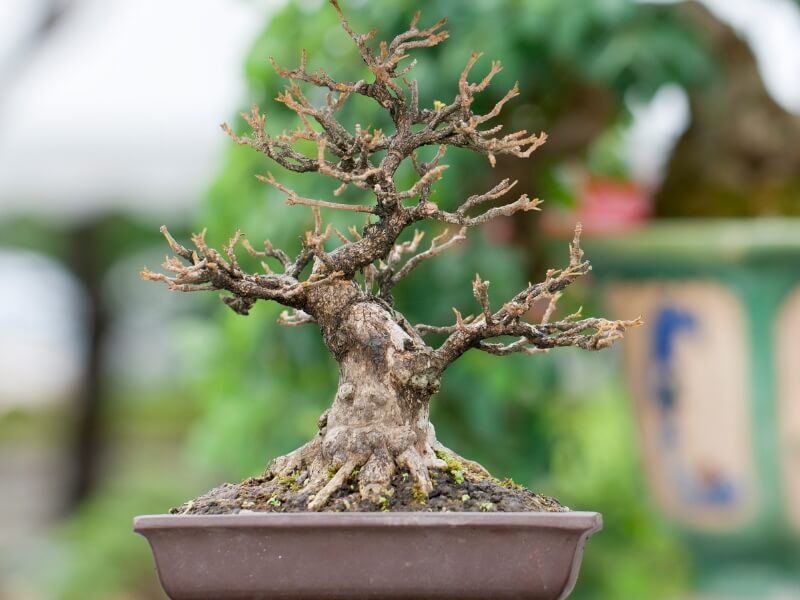
Protection from Wind and Rain
One of the most crucial measures to take when caring for your outdoor bonsai trees during the cold months is to protect them from the wind and rain.
Windy and rainy conditions can dry out your tree’s soil, causing it to become waterlogged, which will lead to root rot. To protect your trees from these wet conditions, it is essential to cover them with a plastic sheet or tarp.
When learning how to prepare bonsai trees for winter, don’t forget to secure the sheet or tarp around the trunk to keep it in place and prevent strong winds from blowing it away.
Placing in a Shady Location
While your outdoor trees love the sun, it is crucial to place them in a shady location during the winter season. The sun’s rays are not as strong during the cold months, but they can still damage your tree if it is exposed for too long.
Also, the cold wind can quickly dry out your tree’s leaves and branches, leading to the death of your bonsai. Placing your tree in an area with partial shade will help to protect it from the sun while still allowing some sunlight to penetrate through.
Monitoring Root Health During Spring
Your bonsai trees will not require frequent watering or fertilizing in cold winters. However, as the temperatures rise in spring, it is crucial to start monitoring your tree’s root health.
The cold months may cause your tree’s roots to become brittle and damaged. Therefore, you need to ensure your tree’s soil is adequately watered during the spring months and inspect the roots to make sure that they are healthy.
Keep Your Bonsai Trees Healthy This Winter!
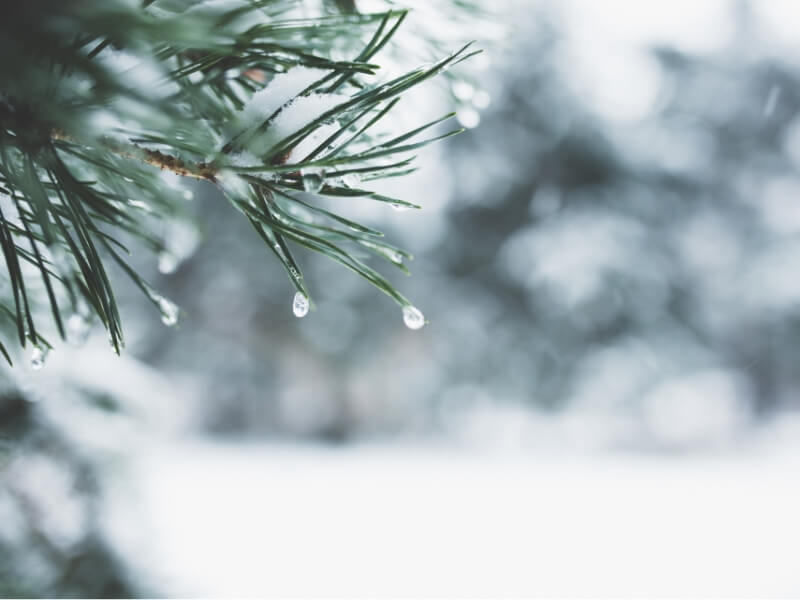
We’ve discussed several important methods that are crucial when learning how to prepare bonsai for winter.
Caring for bonsai trees requires a balance of artistry and practical know-how, and the winter season brings its unique set of challenges. With the guidelines provided in this article, you can keep your bonsai trees healthy and vibrant even amidst the cold.
As fellow bonsai enthusiasts, we’re always intrigued to hear about your own bonsai winter care practices. Feel free to share your experiences and techniques in the comments below. And remember, for more practical advice and insightful articles on bonsai care, be sure to browse through our other blog posts here at Hooked on Bonsai.





0 Comments